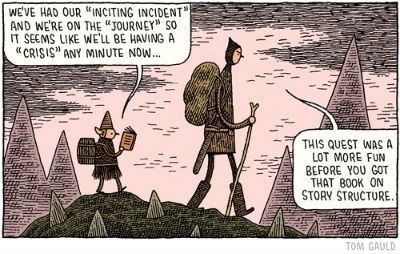Discovering "The Writer's Journey: Mythic Structure for Writers" by Christopher Vogler was one of the highlights of the Writing Drama course I did last year. Not only has it been one of the most influential books on my writing, but it was probably the most enjoyable and exciting book I read last year full stop! Based on Joseph Campbell’s “The Hero With 1,000 Faces” its concepts are the foundation for untold numbers of films and novels, including the Star Wars series, An Officer And A Gentleman, The Matrix and The Lion King.
“The Hero’s Journey is not an invention, but an observation. It is a recognition of a beautiful design, a set of principles that govern the conduct of life and the world of storytelling the way physics and chemistry govern the physical world.”
“The pattern of the Hero’s Journey is universal, occurring in every culture, in every time. It is as infinitely varied as the human race itself and yet its basic form remains constant.”
The first key concept is that there are specific Stages to the Hero's Journey. The main criticism of the Mythic Structure is that it's “formulaic, leading to stale repetition.” Vogler however, whilst recognising that this can happen, is clear that “it should be used as a form, not a formula, a reference point and a source of inspiration, not a dictatorial mandate.”
Regular readers will know I'm a huge fan of the creative flow of the vomit draft principle. Friends will know I'm pretty contrary, keen to bend rules and think outside the box whenever possible. So a prescriptive method of writing is hardly going to be something I advocate, is it?
The Stages of the Hero’s Journey
1. Ordinary World
2. Call to Adventure
3. Refusal of the Call
4. Meeting with the Mentor
5. Crossing the First Threshold
6. Tests, Allies and Enemies
7. Approach to the Inmost Cave
8. Ordeal
9. Reward (Seizing the Sword)
10. The Road Back
11. Resurrection
12. Return with the Elixir
(Some are more instantly understandable and recognisable than others, but all are beautifully and fully explained in the book.)
While these stages – or at least their terminology – seem to particularly suit certain genres of literature, especially fantasy, the Stages can be applied to any genre.
“Modern heroes may not be going into caves and labyrinths, to fight mythical beasts, but they do enter a Special World and an Inmost Cave by venturing into space, to the bottom of the sea, into the depths of a modern city, or into their own hearts.”
Like most structural tools, the Mythic Structure is best utilised in the editing process after the first draft is completed. This – or the 3/5 Act Structure or the Golden Egg Academy's BookMap© – can illuminate the weaknesses in a story's structure. When I first analysed my WIP against it, I was pleased to discover it fitted the framework quite well already (so the overall plotting was doing okay), but it also showed me areas I needed to flesh out or move.
I instantly realised that I was trying to miss out starting with the Ordinary World. I wanted C to leave Earth as quickly as possible (no offence Earth!). The point of attack – where a story opens – is important, especially in kids or YA lit where you have to grab your reader’s attention immediately. I wanted to jump right into the story, full pelt. No dilly-dallying, no backstory, just straight onto that rollercoaster ride. Then I realised that even a book as fast moving in the first chapter as Hunger Games, gives an amazing insight into Katniss’ normal life before she volunteers for the Games and gets whirled off into that world. Okay, it was something I had to do too.
The Structure also helped massively with the spacing of key events, e.g. what acted as the Crossing of the First Threshold and therefore where it needed to come in the story. I knew exactly where the story went up until the Ordeal, but had thought I’d just draw it all together and end it quickly after that. Nope, guess again. I had four more stages to work through. And yes, yet again, I realised the same happened in Hunger Games – you think the Games end and the book finishes, but there are two vital post-Games chapters. Katniss and Peeta have their Reward (their lives and their physical regeneration), The Road Back (the discovery that President Snow is still an enemy and her "rebellion" makes her a continued target), Resurrection (the interviews, the change in her personality and understanding, and the confirmation of President Snow’s enmity) and Return with the Elixir (the arrival back in District 12 and promise of winnings to come (food for everyone)).
The second key concept in the Mythic Structure is that there are Archetypes or commonly recurring character types – Hero, Mentor, Threshold Guardian, Herald, Shapeshifter, Shadow, Ally, Trickster. These caused me more concern as I hadn’t ever thought of my characters in that way at all. I suddenly began to worry that the Hero’s Journey might be too prescriptive, until I read that the archetypes should be seen “not as rigid character roles but as functions performed temporarily by characters to achieve certain effects in a story.”
Phew. That’s more realistic. Then I became troubled that there was no clear Mentor figure like Obi Wan Kenobi or Orpheus (Matrix). Did I need to create a character to more exclusively fit that mould? Not if it’s a function. Instead I have several characters who perform that role in different ways, at different times.
Each character can also perform multiple roles, e.g. one is a Herald and then a Mentor, while another possibly performs the roles of Hero, Mentor (to the other Hero), Shapeshifter and Ally in different situations. Every character should be as flexible and multi-faceted as any real person. Character development is also supported by the Stages – how they grow and change based on what they go through during their Journey creates a realistic character arc.
“The Writer’s Journey” even works fantastically as a personal development handbook and guide – the Stages and Archetypes reflecting and aiding the actual journey of a writer, not just the story journey the writer is writing about! I left my Ordinary World (voluntary redundancy) in order to start writing, having heard the Call to Adventure, which I did try to Refuse several times. I’ve met several Mentors so far and am looking forward to getting started with a new one very soon (my Golden Egg Academy editor)! Completely the first draft of the manuscript could be seen as Crossing the First Threshold and now I’m in the Tests, Allies and Enemies stage (thankfully not many of the latter so far!). Approach to the Inmost Cave will probably involve editing my WIP to death perfection and then the Ordeal will be getting an agent and going after a book deal. I’m the Hero and on the journey I’ll be looking out for Mentors and Allies, trying to turn Threshold Guardians into Allies (particularly publishers!), and giving a wide berth to Shapeshifters, Shadows and Tricksters!
Onward!!
Similar Posts:
- None Found



 Hi, I'm Mel (you figured that out already though, right?!) and this is where I chat about things that relate to and inspire my writing, as well as share some of it.
Hi, I'm Mel (you figured that out already though, right?!) and this is where I chat about things that relate to and inspire my writing, as well as share some of it.
Hi Mel, I must get Vogler. I love Blake Snyder's Save the Cat book or any advice from screenwriters.Have you become a Golden Egg member? Congrats.Would love to find out about it.Did you check out the US writing competitions? They are fun.Even just the first pages or pitch contests.PS you said you liked my twitter tagline. I loved yours – especially I love God.
Thanks Elizabeth, lovely to hear from you 🙂 "Save The Cat" is in my To Be Read pile – it waves to me everyday so I really must get round to reading it, especially now you've recommended it! Yes, thanks, I have been accepted into the Golden Egg Academy which is VERY exciting. I'll no doubt blog about it all soon 🙂 Have only had time for a very quick glance at the US writing comps, but they do look really interesting and I'm planning to check them out properly next week. Thanks again for pointing me in their direction.